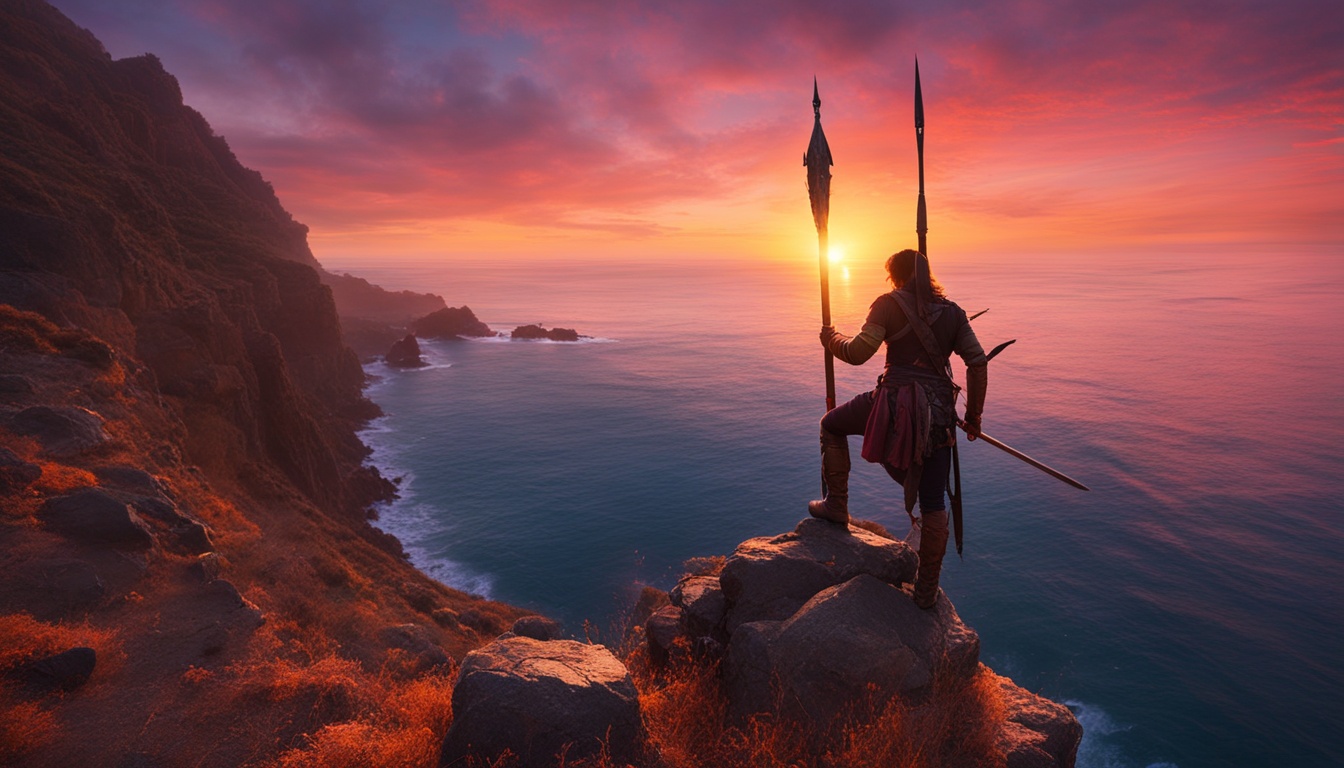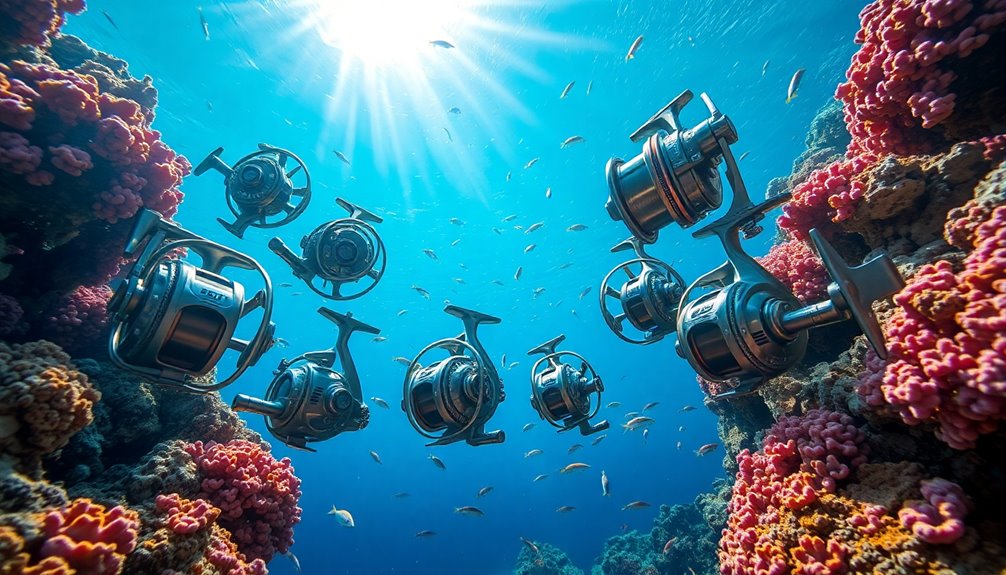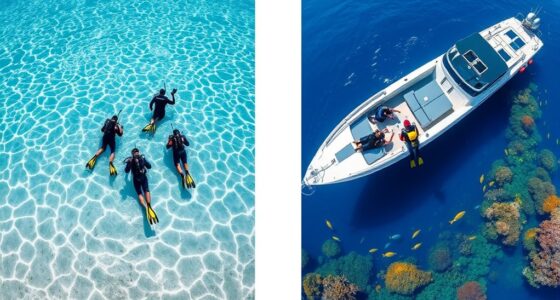Hello, adventure fans! Ready for the thrill of spearfishing? Imagine yourself in the clear waters, hunting for dinner. You’ll explore the ocean’s secrets. This adventure connects you with nature and gives an adrenaline boost. To start your underwater hunting, you need the right gear. I’m here to help with what you need and tips for easy travel with spear gear. Your trip will be smooth and unforgettable.
Key Takeaways:
- Slip tips lead in bluewater spearfishing1.
- Dyneema/Spectra, Cable, and Monofilament are the shooting line types1.
- Bluewater spearguns are longer, bulkier, and have more bands1.
- Spearguns with five+ bands may weigh three to four times the spear’s weight1.
- Most six-band tuna spearguns weigh about 14 lbs (6.5 Kg)1.
- Breakaway adapters connect the shooting line to the floatline or tuna bungee1.
- Floatlines and tuna bungees are key for big catches in bluewater1.
- The choice of floatlines and tuna bungees varies with the target species1.
- Bluewater floats help in battling the fish1.
- Dry training boosts breath-hold for spearfishing2.
- Rest and oxygen refill are needed between dives2.
- A trustworthy dive buddy is vital for safety and success2.
- Shore diving targets fish in rocks, kelp, and sand3.
- Boat spearfishing reaches offshore reefs and islands for specific fish3.
- Bluewater spearfishing seeks large species like marlin and tuna3.
- Free-diving spearfishers can hold their breath for 2-4 minutes, diving 40-60 meters deep3.
Spearfishing Gear Check List: Getting Started
When you start spearfishing, the right gear is crucial for fun and success. Whether new or experienced, you’ll need a checklist of key gear. Always choose high-quality equipment for safety and the right fit.
1. Speargun
A speargun is your main tool for catching fish in spearfishing. You can find pneumatic, band-powered, and hybrid spearguns. Pick one that matches your skills and the fish you’re after. Recommended spearguns include the AB Biller Wood Mahogany Special Speargun4 ($330.00), Mares Sniper Alpha 75 cm Speargun4 ($149.95), and Cressi Apache Speargun4 ($119.95).
2. Wetsuit
Wetsuits keep you warm and comfortable underwater. Choose your wetsuit based on the water temperature. For cold, temperate, and warm waters, the thickness of your wetsuit will vary. Recommended wetsuits include the Cressi Tokugawa Spearfishing Wetsuit4 (~$301.98), SpearPro Spearfishing Wetsuit4 ($359.95), and Riffe Vortex Spearfishing Wetsuit4 ($355.00).
3. Fins
Fins help you move easily and quickly underwater. Choose fins that balance power with maneuverability. Check out the Cressi Gara Modular Fins5 ($149.95), Beuchat Mundial Fins5 ($119.95 to $159.95), and Mares Razor Pro Fins5 ($169.95 to $225.95).
4. Mask and Snorkel
You’ll need a snug mask and a snorkel for clear sight and easy breathing. Recommended masks include the Aqua Lung Micromask5 ($94.95), Cressi Nano Mask5 ($79.95), and Omer UP-M1 Mask5 ($49.95). Good snorkels to consider are the Mares Dual Snorkel Snorkel5 ($35.95) and Cressi Corsica Snorkel5 ($22.95).
5. Weight Belt and Weights
You need a weight belt and weights for the right diving balance. Find a belt with a safety buckle. Options include the Cressi Nylon Weight Belt5, SpearPro Marseillaise Weight Belt5, and Riffe Rubber Weight Belt5.
6. Dive Knife
A dive knife can be handy for safety and utility. It’s used for cutting lines and freeing yourself if needed. Choose a dive knife like the Cressi Borg Knife5, SAALVI Titanium Dive Knife5, or Aquatic Hunt Dive Knife5 with a resistant blade.
7. Gloves and Booties
Gloves and booties protect and help in cold water. Pick gloves for grip, protection, and warmth. Good choices are the Cressi Hunter Gloves5, Mares Flexa Fit Gloves5, and Beuchat Marlin Gloves5. For booties, consider the Cressi Isla Booties5, SEAC HD Dive Booties5, and TUSA Imprex 5mm Dive Boot5 for comfort and warmth.
8. Float and Float Line
A float and line keep you safe and visible. They mark your spot and secure your catch. Pick a durable float and line for the diving conditions.
9. Fish Stringer
A fish stringer holds your catch while diving. Find one long enough for your fish and with a secure lock.
10. Dive Bag
You need a sturdy dive bag for gear transport. Look for space, compartments, and strong construction.
With the right gear, you’re set for spearfishing. Always focus on safety, fish responsibly, and care for the ocean. Get ready for more spearfishing tips coming soon.
Choosing the Right Speargun
When choosing a speargun for spearfishing, it’s key to find one that fits your skill and needs. Beginners should pick a speargun that matches their diving and learning pace.
Band-powered spearguns are recommended for those just starting out. Models like the AB Biller Wood Mahogany Special Speargun, Mares Sniper Alpha, and Cressi Apache are user-friendly6. They provide good performance and accuracy. They’re perfect for newcomers to build their confidence underwater.
Most spearfishers prefer band-powered spearguns over pneumatic types because they’re easier to maintain6. With these spearguns, adjusting the bands for better power is simple.
Roller spearguns are another popular choice6. They’ve been around since spearfishing started and are growing popular again. These spearguns offer power and precision, loved by seasoned spearfishers.
It’s vital to consider the speargun’s length based on your target fish’s type and size67. Shorter spearguns are good for small spaces or smaller fish. Longer ones, ranging from 150cm to 165cm, are ideal for big game in open waters6.
Picking the right spear tip is essential6. You can choose between the Flopper tip for small to medium fish and the Slip Tip for larger species. Each tip suits different fish types.
When it comes to speargun bands, think about stretch and diameter6. Shorter bands offer more power but are harder to load. Choose bands that you can manage and that fit your shooting style.
Finding the speargun that’s right for you involves looking at your personal preferences, skill level, and hunting approach. Spend time researching and testing different spearguns. Find the one that feels right for you.
Selecting the Perfect Wetsuit
When you’re spearfishing, the right wetsuit makes all the difference. It keeps you warm and safe from dangers. The thickness of your wetsuit is key for diving in various conditions and water temperatures8.
For those who love spearfishing, there are great wetsuit options out there. Brands like Cressi, SpearPro, and Riffe are top choices. Cressi has the Tokugawa Wetsuit, made especially for spearfishers. SpearPro wetsuits are known for being durable and flexible. Riffe’s Vortex Wetsuit aims for top performance. Each brand offers unique features to fit different preferences and diving conditions9.
Choosing a wetsuit starts with considering the water temperature. Your wetsuit’s thickness should match your cold tolerance and the temperatures you’ll face. For every 10°F drop in temperature, you’ll need a thicker wetsuit. For 90-80°F, a light 1-2mm wetsuit or rash guard works. But in 50-60°F, thicker wetsuits up to 9mm are best for staying warm8.
Remember to look at the type of neoprene when picking a wetsuit. Freedivers prefer open cell wetsuits for their warmth and insulation. They have soft neoprene filled with tiny air bubbles for trapping heat. Most also have hoods for extra warmth and protection8. Yet, these wetsuits might wear out faster if used for scuba diving due to pressure underwater.
Closed cell wetsuits, on the other hand, are easier to use. They slip on and off without hassle. But, they’re not as warm or flexible as open cell ones. This is because the denser neoprene has fewer air bubbles for insulation8.
The wetsuit’s durability is another important factor. Durable neoprene makes for a less stretchy wetsuit. It’s important to find a good balance between durability and flexibility. This depends on what you prefer and need for your dives8.
Choosing the right wetsuit is all about your comfort, the diving environment, and what the dive demands. With the right wetsuit, you can improve your spearfishing experience and perform your best.
Choosing the Right Fins
When spearfishing, picking the right fins is key for top performance in water. Long fins are ideal because they boost efficiency and propulsion10.
The comfort of the foot pocket is vital. It should fit well and not hurt, even after wearing them a long time. Try different fins to find the one that feels the best.
Stiffness in fins is also crucial for moving through water easily. The right stiffness offers the power needed. Fins made of fiberglass and carbon are great for this, thanks to their stiffness10.
But remember, fins made from fiberglass and carbon cost more than plastic ones. Yet, they last longer and are more efficient, making them a good buy for avid spearfishers10.
Think about the water temperature and how deep you’ll dive when choosing fins. For warm water, thinner blades work well. In cold water, go for blades that are 2 or 3 mm thick10.
Don’t forget to consider a weight belt as well. It helps you stay balanced in water. A good quality belt will fit perfectly with your wetsuit, making your dives more comfortable10.
Choosing the Right Fins: Key Factors to Consider
- Foot pocket comfort
- Stiffness for propulsion
- Material and durability
- Water temperature and blade thickness
- Weight belt adjustability
Choosing the right fins means focusing on water efficiency and your comfort. Think about your spearfishing needs like water temperature and how deep you’ll be diving10.

Good fins make your spearfishing better, helping you move smoothly through the water to your fishing spots. With the right fins, you can dive deeper, stay underwater longer, and catch more10.
Essential Gear: Other Accessories
Besides your main spearfishing equipment, there are other key accessories you should have. These accessories are crucial for a safe and successful spearfishing trip. Let’s dive into some of these important items:
Weight Belt
A weight belt is vital for spearfishing. It balances our body’s natural floatiness, letting us dive deeper. Made of strong nylon or rubber, it adjusts to different weights. Having the right amount of weight is important. Too heavy or too light, and your dive could be off. Remember to include your speargun and other items to find the right weight for your belt11.
Gloves
Never forget your gloves when spearfishing. They protect you from fish spines, spikes, and sharp teeth. Gloves also improve our hold underwater, which is handy with slippery fish. Choose gloves made from tough, yet flexible materials like neoprene or Kevlar. These gloves guard our hands and keep them agile. They even keep our hands warm in cold waters, making dives more comfortable11.
Dive Knife
A good dive knife is essential underwater. It’s useful for cutting lines, freeing from snags, or for self-defense. Pick a knife with a durable, rust-resistant blade. Make sure it’s firmly attached to your gear for quick access. A trusty dive knife brings extra safety to your spearfishing trips11.
Fish Stringer
A fish stringer makes catching fish easier. It’s a strong line with loops or clips for multiple fish. This way, you can carry your catch without an extra bag. Ensure your stringer is made from durable material for underwater use. Also, attach it well to your gear to prevent losses during the dive11.
Dive Bag
A dive bag is great for carrying your gear. It should fit your spearfishing equipment, including the speargun, fins, and wetsuit. Find a durable, water-resistant bag. Some have compartments for better organization. A good dive bag protects and organizes your gear, making it easier to handle11.
Proper accessories make spearfishing safer and more fun. Essentials like a weight belt, gloves, dive knife, fish stringer, and dive bag should not be overlooked. These items improve safety and make your dives smoother. Remember to bring these along on your next spearfishing adventure for a great time underwater.

Safety Considerations
Spearfishing is an exciting adventure that takes you under the sea. It’s very important to stay safe while diving. Here are some important safety tips to follow for a fun experience: Always dive with a buddy to ensure help is nearby in case of an emergency. Additionally, be aware of your surroundings and know the local marine life, as following proper **spearfishing and shark safety tips** can prevent dangerous encounters. By staying calm, avoiding flashy equipment, and respecting the underwater environment, you can reduce risks and enjoy your spearfishing adventure safely.
The Buddy System
The buddy system is a key rule in spearfishing. Always dive with a friend for safety. They can help in emergencies and keep an eye on you. It’s safer to dive together12.
Weather Conditions
Checking the weather is vital before spearfishing. Avoid diving during strong currents, rough waves, and when it’s hard to see. Choose a better day if the weather looks bad. Your well-being is the priority12.
Safety Equipment
Having the right safety gear is a must. Make sure your mask, snorkel, and fins fit well. This helps you swim better and more comfortably. Use a BCD or weight belt for easier movement in water. Don’t forget a dive knife for safety. It can get you out of tight spots13.
Know Your Limits
Knowing your skills is important. Beginners should stick to shallow spots, no deeper than 20 feet. As you get better, you can try deeper dives. Don’t push too hard too soon. Focus on getting better steadily12.
General Safety Precautions
There are other safety tips to remember. Be careful around dangerous sea animals. Learn about them and how to avoid dangers. Keep your spearfishing gear handled safely. Only load your speargun when you’re ready to use it. Avoid getting caught in underwater ropes or lines. Protect the ocean while you enjoy spearfishing12.

| Equipment | Description |
|---|---|
| Mask | A mask with a snug fit allows for clear vision underwater. |
| Snorkel | A snorkline enables you to breathe while floating face down in the water. |
| Fins | Fins provide propulsion and help you swim efficiently. |
| Buoyancy Compensator Device (BCD) or Weight Belt | A BCD or weight belt helps achieve neutral buoyancy and conserve energy during dives. |
| Dive Knife | A dive knife serves as a safety tool and can be used to free yourself from entanglements. |
By following these safety considerations, you’re set for a great spearfishing trip. Safety should always come first. It’s up to us to take care and protect the ocean. Have a safe and fun time spearfishing!
Finding the Perfect Spearfishing Locations
Spearfishing takes you to amazing underwater spots around the globe. It’s fun for both newbies and experts to find new places to dive. You can see colorful reefs or the deep open sea.
When picking a spot, think about how easy it is to get there, the water, and lots of fish. Places like the Maldives have clear waters and fish like tuna and mahi-mahi. Indonesia’s reefs are full of colorful fish and cool underwater scenes.
In the Caribbean, the Bahamas and Cayman Islands have clean waters with lots of marine life. You can hunt big fish like snapper and grouper there. The views under the water are breathtaking.
For those who like adventure, try out remote spots. Norway’s fjords and Papua New Guinea’s reefs are off the common path but offer an amazing challenge.
Statistical data from Link 2:
Planning to go spearfishing abroad usually means flying. Remember to check your luggage size and weight because spearfishing gear is heavy and long. Make sure your passport is valid for six months past your trip. Also, research if you need a visa.
More companies now know about spearfishing trips. In undeveloped areas, planning for meals and where to stay is key. Think about the visibility and water temperature when choosing your gear. Each country has its own fishing rules and what fish you can catch. Taking fish home can be tricky. You might need to donate it, ship it, or carry it in a soft cooler14.
Whether you love catching big fish or just want to explore underwater, there are great places for spearfishing. Pack your gear, pick a spot, and enjoy an incredible dive!
| Spearfishing Location | Key Features |
|---|---|
| The Maldives | Crystal-clear waters, vibrant marine life |
| Indonesia | Mesmerizing coral reefs, diverse fish species |
| Bahamas | Pristine waters, trophy fish |
| Cayman Islands | Thriving marine ecosystems, stunning underwater seascapes |
| Norway | Majestic fjords, unique spearfishing adventure |
| Papua New Guinea | Untouched reefs, off-the-beaten-path exploration |

The Art and Ethics of Spearfishing
Spearfishing is more than just catching fish. It’s an art that demands a close bond with nature and a deep knowledge of the underwater world. This sport supports sustainability, responsible harvesting, and the protection of marine life. Embracing these ethics helps protect our oceans for generations to come.
Responsible fishing is a key part of spearfishing ethics. It means following local fishing rules, respecting size and catch limits, and only hunting species that are plentiful and sustainable. These actions help keep marine ecosystems balanced and prevent overfishing.
“Responsible fishing ensures the sustainability of fish populations and helps conserve marine biodiversity.”
Animal conservation is also a big focus in spearfishing ethics. Spearfishers choose their targets carefully to help save vulnerable species. They can judge a fish’s size, health, and if it’s the right time to catch, supporting conservation.
Sustainability is central to a spearfisher’s way of thinking. They realize the ocean’s gifts are limited and need protecting. Sustainable practices help keep fish numbers stable and ensure spearfishing can continue into the future.

To fully understand spearfishing ethics, looking into scientific studies is important. One study in the Caribbean showed compressor divers caught fish more effectively and had better success than non-compressor divers15. It also found parrotfish to be among the most frequently caught, showing their ecological importance15.
This study also found that small-scale fisheries using various methods and targeting different species can make catches more stable15. Yet, it pointed out that spearfishing needs careful control to avoid harming fish communities over the long term15.
Conclusion
Spearfishing is exciting but requires the right gear, skills, and respect for the ocean. By using key tips from this guide, you can make your spearfishing trips better and catch more fish.
Choosing the correct equipment is vital in spearfishing. Rob Allen’s Euro style spearguns offer great choices. They range from the Tuna 900 speargun, effective up to nine feet161), to the Tuna 1500, which can shoot up to 16 feet162). These spearguns work well for different fish and places.
Despite some challenges like tough laws173) and limited access to spots174), spearfishers have good chances to enjoy their hobby. Shore diving is great for starters181). Plus, online groups182) help fans connect and share tips.
Knowing about dive conditions and marine protected areas is also key. Use tools like Google Earth183) to plan your trips. Always prioritize safety by being aware of dangers like boat traffic184) and following ocean rules185). This ensures a safe and enjoyable spearfishing adventure.
FAQ
What gear do I need for traveling with spear gear?
What type of speargun should I choose as a beginner?
What wetsuit should I use for spearfishing?
What type of fins are recommended for spearfishing?
What other accessories are essential for spearfishing?
What safety considerations should I keep in mind when spearfishing?
What are some popular spearfishing destinations?
What are the ethics of spearfishing?
How can I ensure a successful spearfishing trip?
Source Links
- https://neptonics.com/spearfishing-101/bluewater-spearfishing-gear-breakdown/ – Bluewater Spearfishing Gear Breakdown – Spear Tip To Float
- https://www.noobspearo.com/dry-training-for-spearfishing/ – Dry Training for Spearfishing Guide | Tools, Techniques & Resources
- https://www.oceanhunter.co.nz/resources/spearfishing-basics.html – Spearfishing Basics |Ocean Hunter
- https://www.theperrincollective.com/post/spearfishing-gear-check-list – Spearfishing Gear List 101: A Beginner’s Guide to Essential Equipment
- https://www.theperrincollective.com/post/essential-spearfishing-gear – Essential Spearfishing Gear 101: How to Get Started Spearfishing
- https://neptonics.com/spearfishing-101/the-ultimate-guide-to-selecting-your-perfect-speargun/ – The Ultimate Guide to Selecting Your Perfect Speargun
- https://www.fishing.net.nz/diving-hunting-and-outdoors-in-new-zealand/spearfishing-and-freediving/spearfishing-choosing-the-right-speargun/ – Spearfishing – Choosing the Right Speargun – The Fishing Website
- https://neptonics.com/gear-maintenance/wetsuit-freediving-scuba-wetsuits/ – Choosing the Right Wetsuit for Freediving – Closed vs Open
- https://fishingbooker.com/blog/spearfishing-for-beginners/ – How to Go Spearfishing: The Beginner’s Guide
- https://cyties.com/lifestyle/tips/spearfishing/ – Gear Guide to Start Spearfishing | CYTIES
- https://adreno.com.au/pages/spearfishing-getting-started-guide – Spearfishing – Getting Started Guide
- https://www.scuba.com/blog/spearfishing-tips-for-beginners/ – Spearfishing Tips for Beginners
- https://www.sportsmanboatsmfg.com/blog/67-what-is-spearfishing – What is Spearfishing?
- https://neptonics.com/spearfishing-101/planning-international-spearfishing-trips/ – Planning International Spearfishing Trips
- https://www.ncbi.nlm.nih.gov/pmc/articles/PMC5531497/ – Understanding spearfishing in a coral reef fishery: Fishers’ opportunities, constraints, and decision-making
- https://neptonics.com/spearfishing-101/picking-the-right-rob-allen-speargun-for-you/ – Picking the Right Rob Allen Speargun For You
- https://www.nwdiveclub.com/viewtopic.php?t=17744 – PNW Spear Fishing Education… – Northwest Dive Club
- https://www.noobspearo.com/shore-dive-spearfishing-part-1/ – Guide for Shore dive spearfishing, how to plan and prepare










